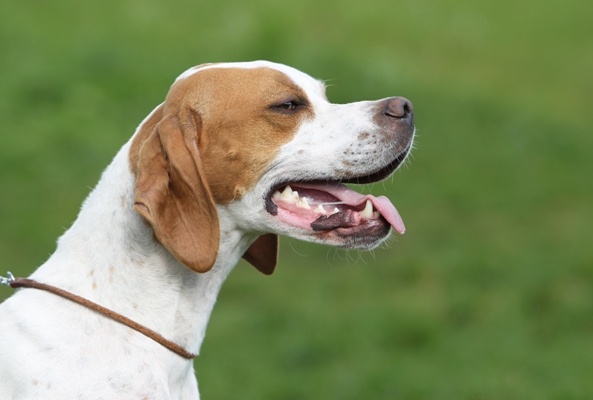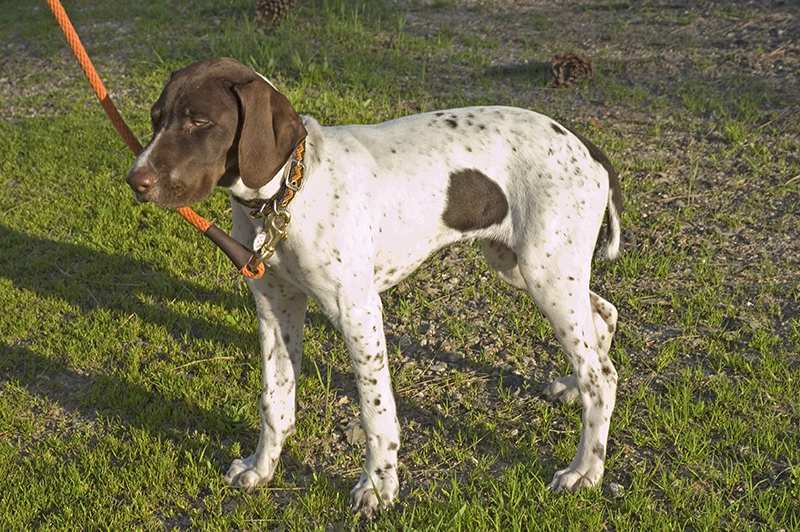English Pointer
Intelligent, patient
This breed has a higher than average probability of developing health issues during its lifetime, hence the cost to insure is above average.

Is this breed right for you?
Try our breed selector quiz to find out your best matching breed!
Insuring a English Pointer?
Get our award-winning Nose-to-Tail Cover with up to $30k annual benefit limit, up to 90% of eligible vet bills back, and no sub-limits.
Get a quick quoteBreed Overview
The English Pointer (or simply “Pointer”) is a large breed of dog originally bred as a gun dog. They are one of the oldest breeds in England, dating back over 3 centuries.
Pointers have a short, smooth, shiny coat which comes in many colours and patterns, such as black, lemon and orange, all with or without white. They are quite low-maintenance dogs, only requiring a quick, soft brush to reduce shedding.
Male Pointers weigh around 25 – 34 kg and stand at 60 – 70 cm tall while females weigh between 20 and 30 kg and stand at 58 – 66 cm tall. The lifespan of the English Pointer is 12 – 15 years.
English Pointers have boundless energy and require rigorous exercise every day to prevent restlessness. Families, unless they have the time and willingness to put in the effort, should not opt for a Pointer. They need an owner who is just as active and energetic as they are. They love to run and walk, and though not water retrievers, some are known to love the water.

Personality and Temperament
English Pointers are quite easy to housebreak and train as they are very intelligent. They are also affectionate, loyal and patient companions who are very adaptable and in-tune with their owner’s emotions – a happy owner will have a happy dog, but a nervous owner may pass its anxiety onto the dog, especially since the Pointer can occasionally be highly-strung. Pointers love children, and when raised with them, they are very good with other pets too.
Pointers also make great watchdogs as they are protective of their family and property and will let their owners know if anything out of the ordinary is happening.
Common English Pointer Diseases & Conditions
Symptoms, diagnosis and treatment
- Hip dysplasia (common among larger dogs) is a condition in which the thighbone and hip joint do not fit together properly, causing pain and lameness. Arthritis can develop later in life as a result of the condition.
- Progressive retinal atrophy refers to a family of eye conditions which result in the deterioration of the retina. In the early stages, dogs may lose their sight at night, and then gradually lose their sight during the daytime too. Most dogs, however, adapt to their vision loss very well unless faced with new or changing environments.
- Epilepsy. Possibly inherited, epilepsy is a neurological disorder which causes seizures that can manifest themselves in unusual behaviour, dizziness, rigidity and fainting spells. Though it is frightening to watch, the prognosis for affected dogs is usually quite good, and treatment is available.
- Neurotropic osteopathy is a rare disease which affects the bones and is caused by abnormalities in the nerves. It usually occurs when the dog is 3 – 9 months old and can lead to spinal degeneration.
- Allergies. The English Pointer can be prone to certain allergies, including food allergies, contact allergies and inhalant allergies. Treatment usually involves removal of the allergen from the dog’s environment or medication.
- Cherry eye is, you guessed it, a condition affecting the eye, causing the third eyelid to well and cause irritation. It generally appears as a red mass (hence the name cherry) on the corner of the dog’s eye. It is treated with surgery.
- Cataracts can occur in Pointers, causing them to develop poor vision and a cloudy appearance in the eyes. They usually occur in older dogs and may be removed surgically if necessary.
- Entropion is a condition which generally occurs in young dogs and causes the eyelid to roll inwards, which can lead to irritation or injury of the eyeball. Signs include rubbing or scratching around the eye area. It can be treated surgically if necessary.
- Chondrodysplasia. Incorrectly referred to as “dwarfism”, Chondrodysplasia is a genetic deformity characterised by abnormally short legs. Some dogs may only be mildly affected, but some can be crippled. Less severely affected dogs lead normal lives but should not be bred to prevent the passage of the defect to offspring.
- Addison’s Disease (Hypoadrenocorticism). This serious illness is caused by the insufficient production of adrenal hormones by the adrenal gland. Pointers with Addison’s disease may have a poor appetite, appear lethargic and vomit. The symptoms of this disease are not always straightforward so it’s best to visit your vet where tests can be performed.
- Demodectic Mange. Demodex mites are passed down from mother to pup but are not transferrable to other dogs or humans. These mites are normal and present in every dog, and typically do not cause any issues. However, a Pointer with a weak immune system could develop demodectic mange. Characterised by red, scaly skin and hair loss, the disease often goes away on its own, but should still be discussed with a vet.
Not all conditions are covered by Pet Insurance. For details of Bow Wow Meow Pet Insurance cover, refer to the Product Disclosure Statement.

History
The term “pointer” was used to describe any hunting breed that pointed at its prey. While it is believed they originated in Spain, little is known about the Pointer’s origins. Pointer-like dogs have existed in England since as early as 1650. The modern Pointer probably came about as a result of Spanish Pointers being brought to England around 1712 and possibly cross-breeding them with the Foxhound, Greyhound, Bloodhound, and some setters. These breeds (and possibly more) lent their incredible sense of smell, speed, elegance, endurance and temperament to create the breed we see today.
English Pointers were most likely first brought to the USA by early colonists, though they weren’t really documented until the Civil War era. They were first recognised by the AKC in 1884 and the American Pointer Club was established in 1938.
As of 2013, the Pointer ranks as 103rd in the AKC’s 180 registered breeds.

English Pointer Facts!
- The logo of the Westminster Kennel Club features an English Pointer called Sensation, who is credited with establishing the breed in the US.
- A Pointer named Judy served as a ship’s dog and was stranded on a desert island with some of the crew after their ship, the HMS Grasshopper, sunk. She is credited with saving the crew’s lives after she found a source of fresh water. They managed to make their way to Sumatra and become prisoners of war. She died at the age of 14 in Tanzania and was awarded with the Dickin Medal by the People’s Dispensary for Sick Animals in 1947 for her courage and bravery.
Free engraved pet ID tag on sign up3
Customer Satisfaction
21 day cooling off
Easy to use Pet Portal

GapOnly® in vet claims
SEE MORE
English Pointer Rescue Australia: https://www.facebook.com/English-Pointer-Rescue-Australia-155164284602350/




